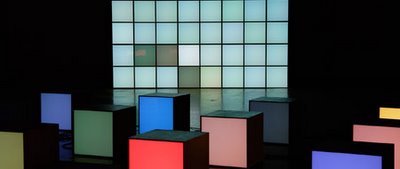
Strangely, one enters a space which is normally abstract, computerized, unhuman, digital--if you let yourself become absorbed and entranced by the play of color, you feel as if you are in some theoretical, pixelated world; there is a loss of the sense of the body. It’s a sort of virtual-reality space, but, importantly, it’s a low-tech one: the pixels are couple feet square, improbably large, as if the image is of bad resolution, antiquated.
I immediately associated this low-fi experience with grainy, blown-up photography, which has a negative connotation, one of dimly-lit, forbidden revelations: the photographs of prisoner tortures at Abu Ghraib, of underground porn, old mug shots, celebrities topless on a beach caught by the paparazzi. Strangely, I associated immorality with poor quality images; on the converse, then, fidelity is morality.
Bullock plays with this idea in another work, my favorite in the show, in which she projects a grainy, black and white off-putting photograph of a crowd of people who are either singing or screaming--both seem plausible--onto the gallery wall. It is clearly an old image, and it feels like something out of Schindler’s List. In a deft move, she places the projector around waist-level, so that one sees the grainy photograph and moves closer, but can’t help eclipsing the image’s projection, casting a shadow of ones body over the contorted faces. Importantly, ones images is sharp and defined, while at this close distance, the photograph is so pixelated as to border on abstraction. On a nearby wall is a printed version of the same photograph with someone’s shadow over it in the same way. That person is clearly a conductor with passionate, outraised hands--a classic image of a choir with the shadowed outline of a conductor in the foreground. I turned back to the projection, and hoped that the people in the grainy photograph were indeed singing. The way the viewer’s outline is so sharp and the photograph so grainy that the moral and immoral associations of each are compelling: as conductor, am I to feel pathos, fear, joy? Am I the cause of what seem like such abnormally emotional faces? Am I a dictator, or an inspiration? Are those blurred images, which have been abstracted and lack clean lines, still representations of humanity?
On a simpler and less interpretive scale, the art Bulloch makes is highly successful in altering and disrupting the viewer’s perception, with a focus on emphasizing or dissolving the body. She seems to confront the membrane which separates actual physical space and conceptual or digital reality, making the viewer aware of how each carries its set of principles, and the interactions between those worlds is inevitably moral. She says in the catalog interview that the work depends on the viewer, not to explicitly interact, but to be “inter-passive” (versus inter-active). There are no buttons to push or levers to pull, but the viewer’s engagement with the work “is discovered the moment the work is completed by the presence of the viewer.” What I like about this distinction is the way it gives high regard to this inhuman, otherworldly space: the way we often interact with the digital realm is to push buttons and pull levers; in her art, we need only confront it morally. Is it something that we created, but now exists on its own terms?
Wish I, too, could return to Oxford.
ReplyDeleteMaybe another day--when we both are cats.
Those two sentences that begin with your association of low-fi photos--well-crafted, good sir.
Nice stuff Blake. I agree with your points. I particularly like the quote 'in her art, we need only confront it morally'.
ReplyDeleteLiving in Oxford gives me the benefit of being able to revisit it later this month. Must remember to 'confront it morally'!
Paul